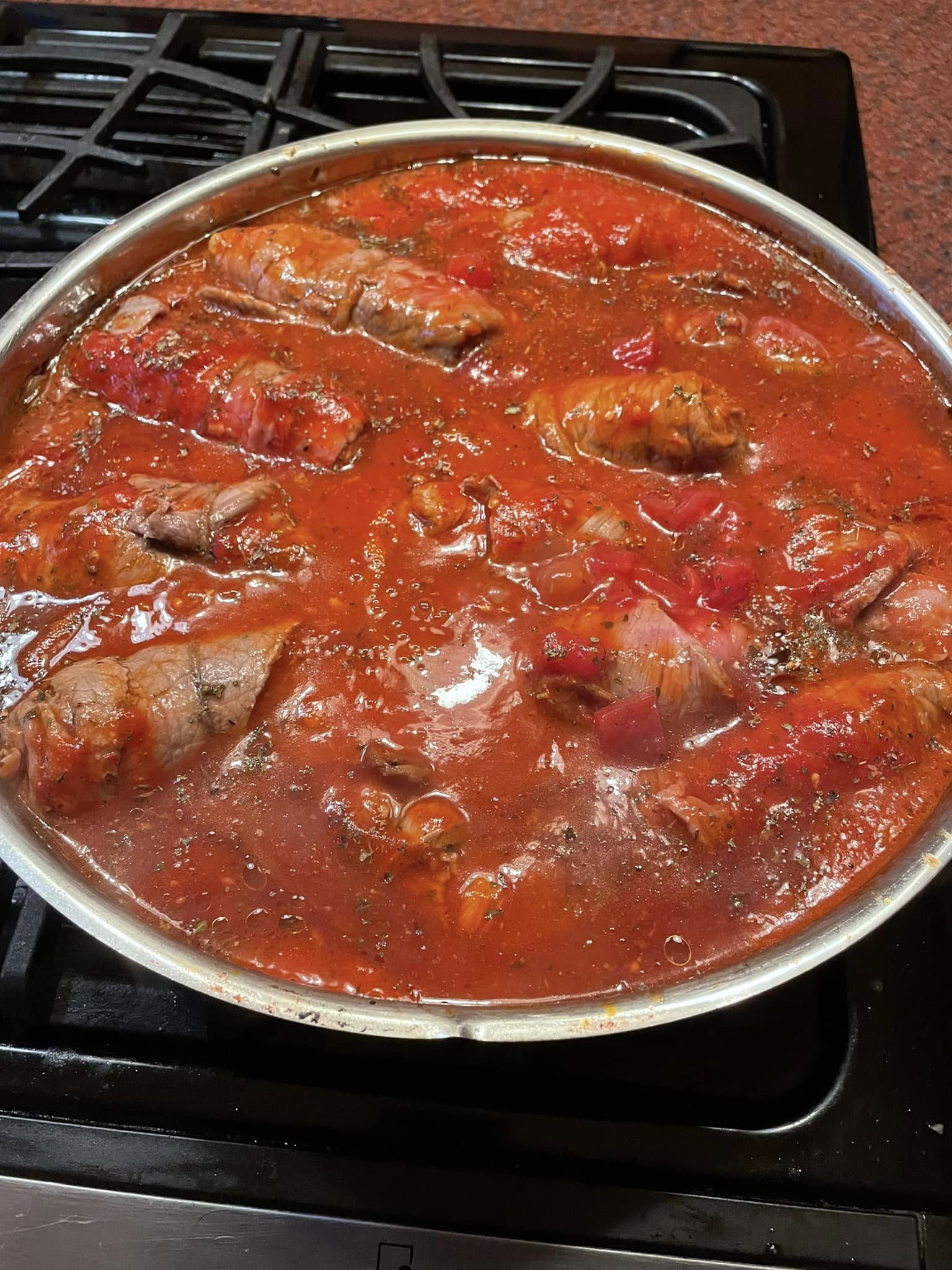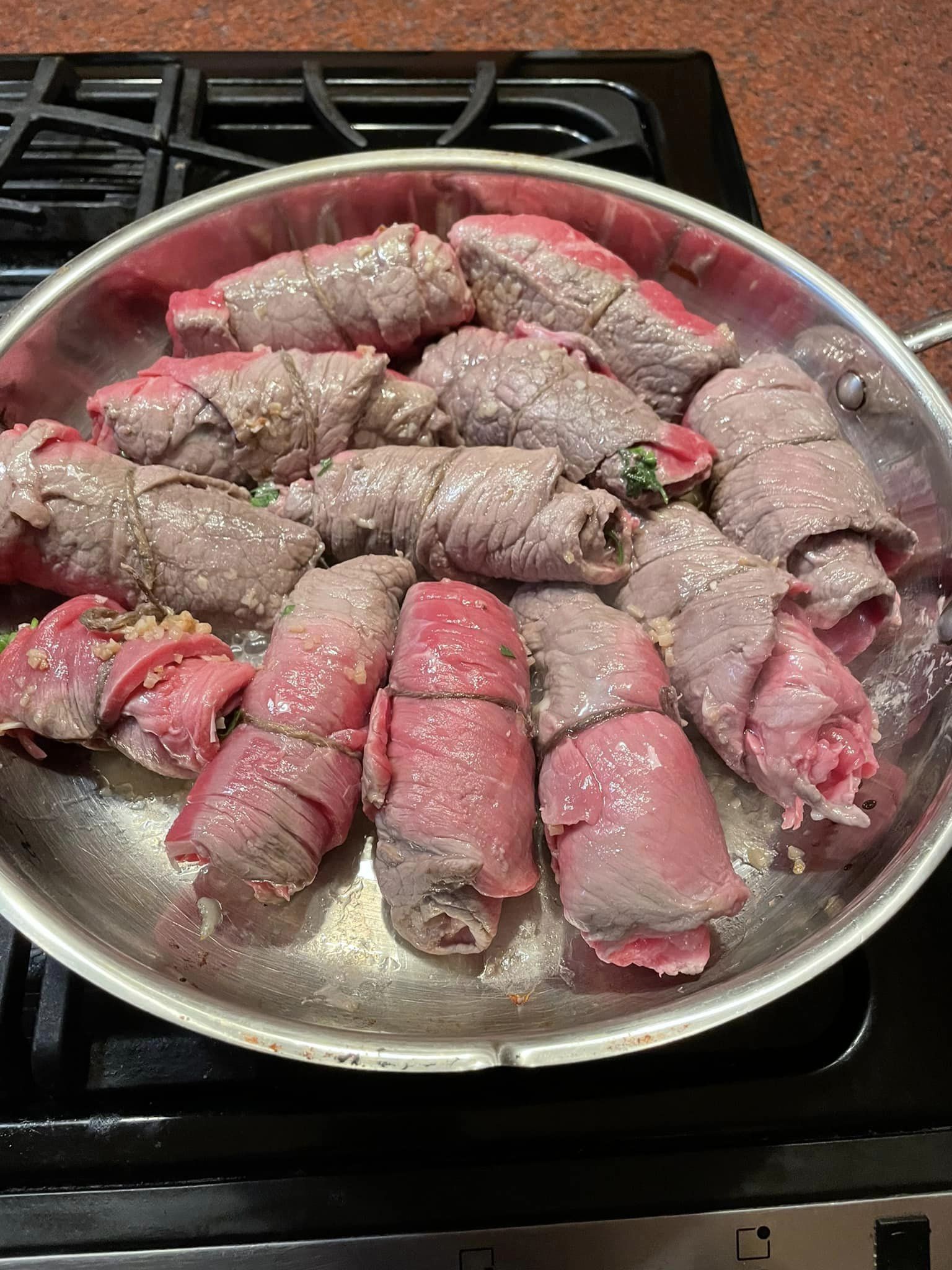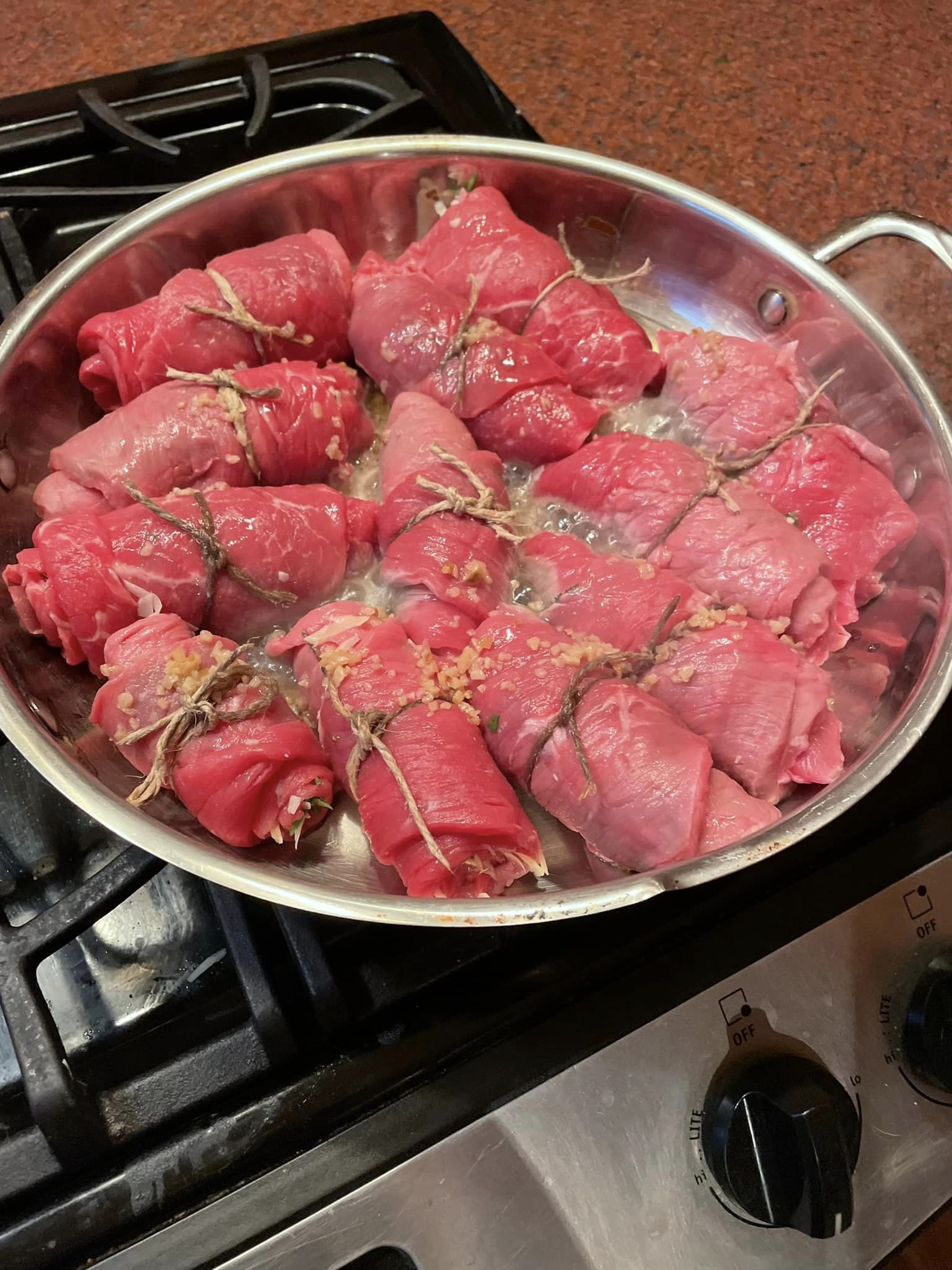Soprano’s Braciole
Soprano’s Braciole is a dish steeped in Italian tradition, carrying with it the warmth of Sunday family dinners and the slow-simmered flavors of Old-World cooking.
Thin slices of beef are transformed into delicate rolls, filled with garlic, Romano cheese, and fresh parsley, then wrapped in savory prosciutto for depth and richness. Simmered gently in a robust red wine and tomato sauce, the meat becomes fork-tender, absorbing every layer of flavor from the herbs and sauce.
Paired first with pasta and then enjoyed as a hearty main course, this dish is not just food—it’s comfort, heritage, and the kind of meal that lingers in memory long after the last bite.

Why People Will Love Soprano’s Braciole:
A dish rooted in tradition – Braciole is more than just rolled beef; it’s a classic Italian comfort food, cherished in family kitchens for generations, carrying with it the feeling of home and heritage.
Layers of rich flavor – The combination of garlic, Romano cheese, parsley, and prosciutto wrapped inside beef creates a balance of salty, savory, and aromatic notes that slowly melt together as it simmers.
Tender, melt-in-your-mouth texture – After hours of simmering in red wine and tomato sauce, the beef becomes fork-tender, infused with deep, soulful flavors that only slow cooking can achieve.
A meal that feels like two courses in one – The pasta soaks up the luxurious sauce as a first course, while the braciole itself serves as a hearty centerpiece, making it both abundant and versatile.
An experience, not just a recipe – Preparing, rolling, tying, and simmering the braciole is a ritual that connects the cook to the essence of Italian cooking—patience, love, and the joy of sharing food around the table.
Key Ingredient:
Beef round slices – Thin, lean cuts that serve as the canvas for flavor; when pounded and slowly simmered, they transform into tender rolls that absorb every nuance of the sauce.
Prosciutto – A delicate layer of cured richness, adding salty depth and an unmistakable Italian character to each bite.
Romano cheese – Sharp and tangy, it melts into the filling, binding the garlic and herbs together with bold, savory undertones.
Fresh parsley and garlic – A fragrant duo that brightens and balances the richness of the meat, ensuring the filling is both earthy and aromatic.
Dry red wine – Not just for deglazing but for layering the sauce with complexity, lending body and warmth that elevate the tomato base.
Tomato purée and basil – The soul of the sauce, marrying acidity and sweetness with fresh herbal notes, creating the velvety backdrop that carries the braciole.
Expert Tips:
Pound with purpose – When flattening the beef slices, aim for uniform thickness (about ¼ inch). Even thickness ensures consistent cooking, helps the rolls hold their shape, and makes them tender after the long braise.
Season in layers – Lightly season the beef itself before adding the filling. The prosciutto and Romano cheese are naturally salty, so balance is key—season gently rather than heavily.
Tie tightly but not harshly – Use kitchen twine to secure each roll snugly, but don’t over-tighten. Overly tight strings can cut into the meat and cause the filling to leak. A well-tied roll ensures the filling melds with the beef without spilling.
Brown deeply for flavor – When searing the braciole, resist the urge to turn them too quickly. A rich, golden-brown crust forms the foundation of the sauce’s depth, as the fond (caramelized bits) enrich the wine and tomato base.
Choose wine wisely – A dry red wine like Chianti or Sangiovese complements the acidity of the tomatoes and enhances the savory beef. Avoid overly sweet or fruity wines, as they can throw off the sauce’s balance.
Control the simmer – Keep the sauce at a very gentle simmer for the full two hours. A slow, steady braise breaks down the beef’s fibers gradually, producing tender rolls that almost melt into the sauce.
Taste and adjust – Halfway through cooking, taste the sauce. Add a splash of water if it’s too thick or a pinch of sugar if the tomatoes lean too acidic. Great braciole is all about balance.
Rest before serving – After simmering, let the braciole rest in the sauce for at least 10 minutes before slicing. This allows juices to redistribute and flavors to harmonize.

Soprano’s Braciole
Ingredients:
For the Braciole:
4 thin slices boneless beef round (1 pound)
1 garlic clove, finely chopped
2 tablespoons grated Romano cheese
2 tablespoons flat-leaf parsley, chopped
Salt and pepper
4 thin slices prosciutto
String for tying

For the Sauce:
2 tablespoons olive oil
2 garlic cloves, lightly crushed
1 cup dry red wine
4 cups tomato puree
4 fresh basil leaves, torn into small pieces
Water (if needed)

For Serving:
1 pound ziti or penne pasta
Instructions:
Step 1: Prepare the Beef
Place the beef slices between two pieces of plastic wrap. Pound gently to about 1/4 inch thick.
Remove the top piece of plastic wrap.
Step 2: Make the Filling
In a small bowl, combine the finely chopped garlic, grated Romano cheese, parsley, salt, and pepper.
Spread the mixture evenly over each beef slice.
Step 3: Add Prosciutto
Lay a slice of prosciutto over each beef slice.
Roll each slice up tightly like a sausage and tie with string to secure.
Step 4: Brown the Braciole
In a Dutch oven, heat the olive oil over medium heat.
Add the lightly crushed garlic cloves and the braciole rolls. Cook, turning the meat until browned on all sides.
Step 5: Add Wine and Simmer
Pour in the red wine and let it simmer for about 2 minutes. Remove the garlic cloves.
Step 6: Make the Sauce
Add the tomato puree and torn basil leaves to the pot. Stir well.
Cover and let it simmer for 2 hours, turning the braciole occasionally. If the sauce becomes too thick, add a bit of water.
Step 7: Cook the Pasta
While the braciole is simmering, cook the ziti or penne according to package instructions. Drain.
Step 8: Serve
Serve the sauce over the hot pasta as a first course.
Serve the braciole as a second course.
Enjoy your hearty Italian meal!
Important Notes When Making Soprano’s Braciole:
Meat selection matters – Use thin slices of beef round or flank steak. The cut doesn’t need to be expensive since the long braise tenderizes it, but it must be thin enough to roll and absorb flavor. Ask your butcher to slice it for braciole if possible.
Prosciutto enhances but can be adjusted – Its salty, cured flavor is traditional, but if unavailable, pancetta or even thin slices of capicola can work. Just be mindful of the salt level in your filling.
Sauce consistency is key – The tomato purée will thicken as it simmers for two hours. Stir occasionally and add small amounts of water or broth to keep the sauce silky, not pasty. The sauce should cling to pasta without feeling heavy.
The string is non-negotiable – Securely tying the rolls prevents them from unraveling in the sauce. Use kitchen twine, not toothpicks, since twine holds better during the long simmer. Remember to remove the strings before serving.
Simmer, don’t boil – High heat will toughen the beef, while a gentle simmer slowly breaks down connective tissue. The patience of low-and-slow cooking is what makes braciole memorable.
Two courses in one meal – Traditionally, the pasta is served first with the rich tomato-basil sauce, and the braciole is enjoyed as a second course. This structure honors the Italian way of savoring meals in layers.
Make ahead for depth – Braciole tastes even better the next day, as the flavors meld further. Store it in the sauce, tightly covered, and reheat gently on the stovetop before serving.
Pairing is part of the experience – A bold Italian red wine, like Chianti or Montepulciano, complements the richness. For sides, think rustic—crusty bread, roasted vegetables, or a simple green salad.
How to Enjoy This Soprano’s Braciole After Cooking
Rest before slicing – Once the braciole has finished simmering, allow it to rest in the sauce for 10–15 minutes with the lid on. This pause lets the juices settle and prevents the rolls from falling apart when sliced.
Serve in the traditional Italian way – Begin with the pasta course: toss ziti or penne with a generous ladle of the tomato-basil sauce, ensuring every piece of pasta is coated in the slow-simmered richness. Sprinkle with freshly grated Romano or Parmesan for a perfect start.
Present the braciole as the centerpiece – After the pasta, serve the sliced beef rolls as the main course. Arrange them neatly on a platter, spooning additional sauce over the top so each piece is glistening and inviting.
Enhance with thoughtful sides – Pair the braciole with rustic accompaniments like roasted seasonal vegetables, sautéed greens, or a crisp salad dressed simply with olive oil and lemon. A loaf of crusty Italian bread is essential for soaking up the sauce.
Pair with wine for a complete experience – A dry Italian red such as Chianti, Barbera, or Sangiovese balances the acidity of the tomato sauce and the richness of the meat. For a lighter option, serve sparkling water with lemon to refresh the palate.
Savor the ritual – Braciole is not a rushed meal. It is meant to be enjoyed slowly, in courses, with conversation. Take time between bites to appreciate the tenderness of the beef, the aroma of basil, and the complexity of wine-soaked sauce.
Enjoy leftovers with creativity – Braciole often tastes even better the next day. Slice it thin for sandwiches with crusty bread, melt-in-your-mouth cheese, and a spoonful of the tomato sauce, or reheat gently for another classic Italian dinner.
Nutrition Information:
For Soprano’s Braciole (based on one serving out of about 6, including pasta and sauce):
Calories: 520 kcal | Total Fat: 24 g | Saturated Fat: 7.9 g | Monounsaturated Fat: 10.6 g | Polyunsaturated Fat: 1.7 g | Cholesterol: 85 mg | Sodium: 780–900 mg (depending on added salt and prosciutto) | Total Carbohydrates: 42 g | Dietary Fiber: 4.8 g | Sugars: 9 g | Protein: 34 g
Frequently Asked Questions:
Can I prepare the braciole ahead of time?
Yes. You can assemble and tie the beef rolls a day in advance, then refrigerate them until ready to cook. This actually helps the flavors meld into the meat. Simply bring them to room temperature before browning and simmering.
What is the best type of beef cut to use for braciole?
Thin slices of beef round or flank steak work best because they’re lean yet tenderize beautifully with slow cooking. The slices should be about ¼ inch thick—thicker slices won’t roll well, and thinner ones may fall apart.
How do I keep the rolls from unraveling while cooking?
The key is to tie the rolls tightly with kitchen twine, spacing the string every 2 inches. If twine isn’t available, secure with toothpicks, but twine is sturdier and easier to remove before serving.
Why is wine used in the sauce, and can I omit it?
Red wine deepens the flavor of the sauce, adding richness and subtle acidity. If you prefer not to use wine, you can substitute with extra beef broth plus a teaspoon of balsamic vinegar to mimic the balance.
How should I serve braciole in a traditional Italian meal?
Traditionally, the sauce is served first with pasta (like ziti or penne), then the braciole rolls are served separately as the main course. This two-step serving style highlights both the sauce and the meat as distinct stars of the meal.
How thin should the beef slices be for the best result?
The beef should be pounded to about ¼ inch thick. This ensures it’s thin enough to roll easily, but still substantial enough to hold the filling and stay tender during the long simmer.
Can I substitute prosciutto with another ingredient?
Yes. If prosciutto is unavailable, thinly sliced pancetta or even smoked ham can be used. Each will add a slightly different flavor—prosciutto is delicate and salty, while pancetta adds a deeper, smokier profile.
How do I prevent the sauce from becoming too thick while simmering?
Since braciole simmers for 2 hours, the sauce may reduce more than desired. If this happens, simply add a small amount of water or beef broth as it cooks, stirring occasionally to keep the texture silky.
What’s the secret to keeping the braciole tender?
Low and slow cooking is key. Maintain a gentle simmer—never a rapid boil. A heavy Dutch oven or enameled pot helps retain even heat, ensuring the meat becomes fork-tender without drying out.
Can I cook braciole in a slow cooker instead of on the stovetop?
Absolutely. After browning the rolls and deglazing with wine, transfer everything to a slow cooker with the tomato purée and basil. Cook on low for 6–7 hours, or until the beef is tender and infused with flavor.